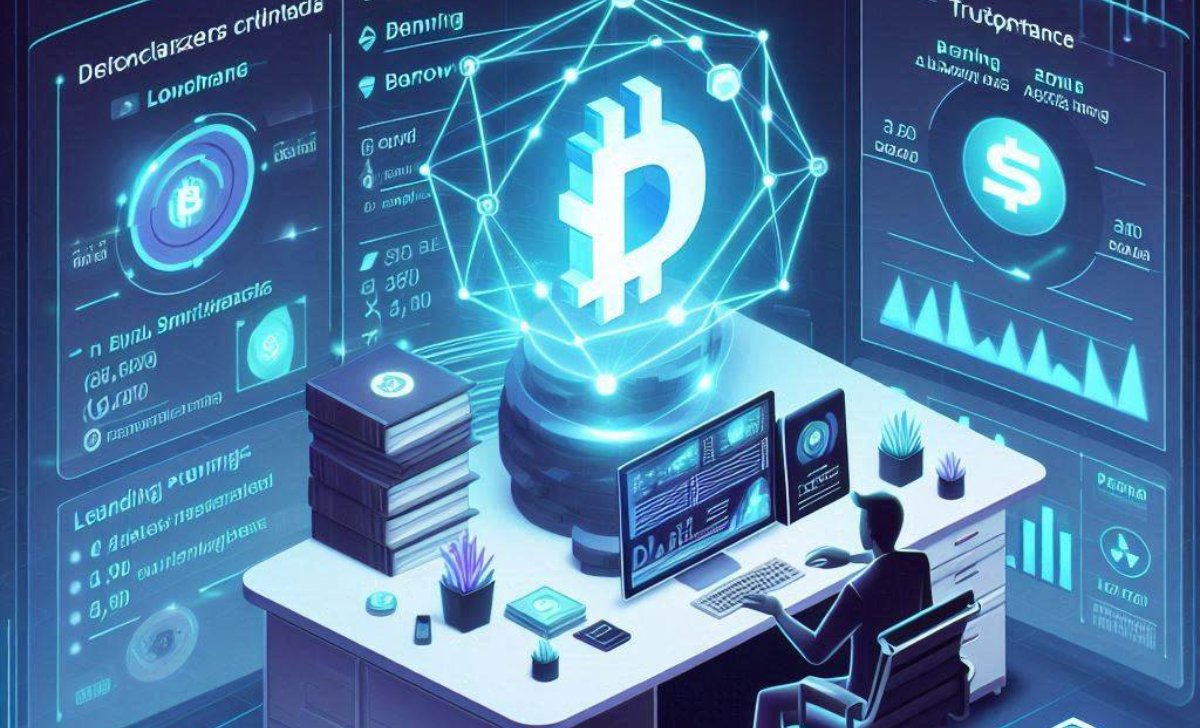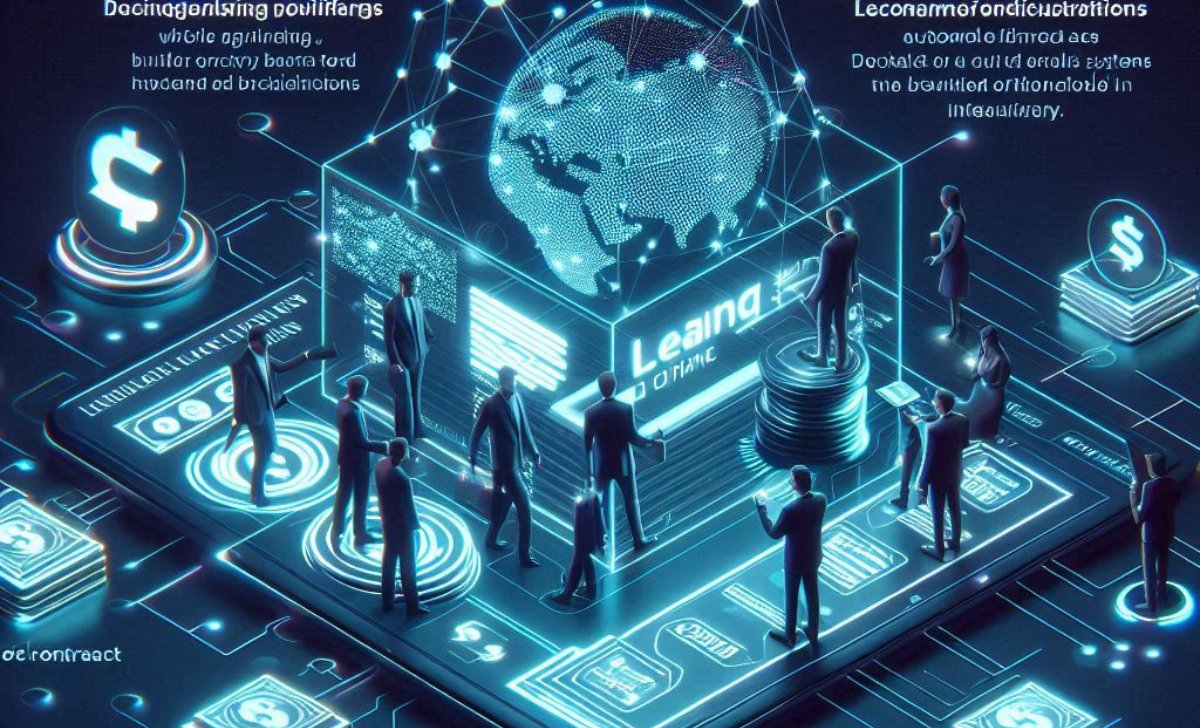DeFi Lending Platforms are transforming how people lend and borrow money in a decentralized, borderless financial system. It offers attractive interest rates, flexible access to capital, and the freedom to operate without traditional banks or intermediaries.
It will be examined in this guide of TopCoin9 through key aspects including how they work, current lending rates, potential risks, top platforms in 2025, comparison criteria, and future trends.
What Are DeFi Lending Platforms?

DeFi lending platforms are decentralized applications (dApps) built on blockchain networks that allow users to lend or borrow digital assets without intermediaries. Unlike traditional lending systems governed by banks and financial institutions, these platforms use smart contracts—automated programs that enforce terms transparently and autonomously.
Lenders earn interest in their crypto assets by providing liquidity to the protocol, while borrowers use their own crypto as collateral to receive loans. The whole process is peer-to-peer, permissionless, and typically operates on blockchains like Ethereum, Polygon, or Binance Smart Chain.
A defining feature of DeFi lending is non-custodial control—meaning you retain full ownership of your assets throughout the process. According to Investopedia (2023), this non-custodial nature is one of the key drivers behind the growing popularity of DeFi lending protocols.
While these platforms offer attractive interest rates and flexibility, users must understand how they work before participating. Now that you understand the foundation, let’s dive deeper into what’s new in DeFi lending this year through the content below!
How DeFi Lending Works in 2025
In 2025, DeFi lending platforms have evolved with smarter technologies, broader asset support, and tighter integration with real-world finance. Here’s a snapshot of how lending works today:
- Deposit: Lenders deposit tokens into a liquidity pool.
- Borrow: Borrowers take loans by locking up other tokens as collateral.
- Interest Generation: Lenders earn variable or fixed interest based on protocol rules and market demand.
- Smart Contracts: Automatically manage the loan lifecycle, including repayments and liquidations.
Notably, many platforms now support real-world assets (RWA), allowing tokenized versions of treasury bonds, invoices, or real estate to be used as collateral. Projects like Centrifuge and Maple Finance have pioneered this concept, creating more stability in lending markets (CoinDesk, 2024).
DeFi lending is also benefitting from the integration of AI-driven risk scoring, making it easier to assess loan risk profiles without sacrificing decentralization.
But even with these innovations, interest rates remain the central factor in choosing the right platform — which we’ll explore next!
DeFi Lending Rates in 2025 – What to Expect

Rates on DeFi lending platforms fluctuate based on supply and demand dynamics. In 2025, the average Annual Percentage Yield (APY) for stablecoin lending ranges between 3% and 7%, while riskier assets like altcoins may yield 10% or more, depending on volatility and liquidity.
For example:
- USDC lending on Aave v3 averages around 4.8% APY.
- ETH lending on Compound may offer 2.3% APY depending on utilization.
- DAI loans on Morpho can provide optimized yields, sometimes up to 6.5%.
These rates are generally higher than traditional savings or money market accounts, making DeFi loan platforms an attractive option for yield seekers. However, higher returns often come with higher risks.
One study by Chainalysis (2024) revealed that users flock to platforms with transparent algorithms and real-time rate adjustments, which help stabilize the ecosystem during market turbulence.
As you consider earning yields in DeFi borrowing, it’s vital to understand the risks that come with them. Let’s explore that in the next section!
Risks of Using DeFi Lending Platforms
While DeFi lending offers autonomy and higher yields, it also exposes users to several types of risk:
- Smart Contract Vulnerabilities: Smart contracts are not infallible. Bugs or exploits can result in massive losses. The infamous bZx exploit in 2020 cost users over $8 million, while Euler Finance lost over $190 million in 2023 due to code manipulation (CoinTelegraph, 2023).
- Liquidation Risk: Borrowers can have their collateral liquidated if the value of their assets drops below a certain threshold. This risk is heightened in volatile markets.
- Oracle Manipulation: Price oracles feed asset prices to smart contracts. If an oracle is manipulated or faulty, it can result in incorrect liquidations or undercollateralized loans.
- Regulatory Uncertainty: As governments catch up with DeFi’s rapid growth, regulation may impact how these platforms operate. In 2024, the SEC fined several U.S.-based DeFi operators for offering unregistered lending services (SEC.gov, 2024).
Despite these risks, millions still use DeFi lending platforms because the rewards often outweigh the dangers — especially when risk management strategies are applied. Let’s now explore the most reliable platforms shaping the DeFi lending scene in 2025!
Top DeFi Lending Platforms in 2025

Here are the standout DeFi lending platforms dominating 2025 based on user volume, innovation, and security:
- Aave v3: Aave remains a leader thanks to its multi-chain support and isolation mode for high-risk assets. It’s fully audited and integrated with institutional-grade tools like Fireblocks.
- Compound III: Known for its simplicity and minimal risk exposure, Compound has updated its protocol with enhanced oracle protection and token economics.
- Morpho Blue: A peer-to-peer lending layer that optimizes yield while reducing the dependency on liquidity pools. Morpho’s growth in 2025 has been rapid due to improved capital efficiency.
- Venus Protocol: Especially popular on Binance Smart Chain, Venus offers high-yield stablecoin lending and supports cross-chain assets.
- Spark Protocol (by MakerDAO): Built for the DAI ecosystem, Spark offers deep integration with Maker’s collateralized systems, ensuring overcollateralization and stability.
Each of these platforms brings unique strengths, from user-friendly dashboards to composability with other DeFi tools. Whether you’re exploring lending options or looking for the best crypto to buy with yield-generating potential, understanding these platforms is a smart first step. Next, let’s explore what makes a platform “right” for your needs!
How to Choose the Right DeFi Lending Platform
Choosing the best DeFi lending platform isn’t just about chasing the highest APY. Here are key factors to evaluate:
- Security Audits: Look for platforms audited by reputable firms like CertiK or Trail of Bits.
- Transparency: Protocols with open-source code and clear governance win user trust.
- Asset Support: Ensure the platform supports the tokens you want to lend or borrow.
- User Experience: Simple UX and integration with wallets like MetaMask improve usability.
- Insurance & Safeguards: Some platforms partner with insurance protocols like Nexus Mutual.
According to a report by Messari (2024), platforms that consistently offer clear documentation and respond quickly to threats retain user confidence even during bear markets.
Now that we’ve covered the current landscape, let’s take a glimpse at where DeFi lending might be headed beyond 2025. Find out more in the next section!
Future Trends in DeFi Lending Beyond 2025

The future of DeFi lending platforms is bright and complex. Here are some emerging trends:
- AI-Powered Lending: Some platforms are experimenting with on-chain credit scores, powered by AI, to offer uncollateralized loans based on wallet behavior.
- Tokenized Real-World Assets (RWA): Treasury bills, real estate, and invoice factoring will become more common than collateral in lending pools.
- Layer 2 Expansion: With rising gas fees on Ethereum, lending platforms are moving to Layer 2 solutions like Arbitrum and Optimism for faster and cheaper transactions.
- Institutional DeFi: Large firms are entering the space via regulated DeFi protocols—this hybrid approach is already visible with BlackRock’s involvement in tokenized assets (Forbes, 2024).
These innovations signal a maturation of DeFi lending, pointing toward a more inclusive and interoperable financial ecosystem.
Conclusion
DeFi Lending Platforms are redefining the future of finance by offering users more control, better rates, and greater transparency. We hope this guide has helped you understand the key risks, benefits, and top platforms to consider in 2025. Don’t forget to follow our latest articles at TopCoin9 for more in-depth insights into the world of DeFi and crypto!

Emily Thompson is a highly skilled crypto writer and strategist with extensive experience in blockchain journalism, having contributed to Cointelegraph and Binance Academy. At TopCoin9, she ensures high-quality, SEO-optimized content that educates and informs the crypto community.
Email: [email protected]












